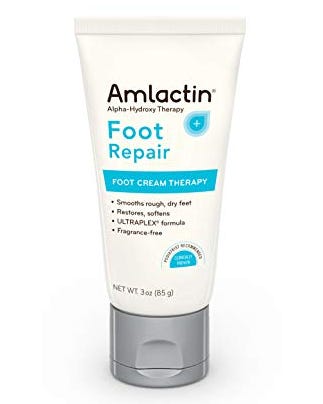Ahhh, sandal weather. Gotta love it—except when all that exposure brings to light (literally) that your feet aren’t in the best shape of their life. Maybe you notice rough patches, cracked skin, or peeling, for instance.
First, cut your footsies some slack. “Some degree of skin peeling on the feet is normal, especially during the summer months when our feet are exposed to the sun, heat, and sand,” says Cameron Rokhsar, MD, double board-certified dermatologist and dermatologic surgeon and professor of dermatology at Mount Sinai.
Adds Rebecca Pruthi, DPM, a podiatrist, and owner of Foot Care of Manhattan, “We are on our feet all the time and the constant pounding and walking can cause cracking and scaling of the skin.”
That doesn’t mean you have to just deal with it. The key is to first identify what you’ve got going on down there. (Keep reading for some possible scenarios!) The remedy may be as simple as a pumice stone and a little lotion, could require a trip to your pharmacy—or, in some cases, a visit with your doctor.
Meet the experts:
Rebecca Pruthi, DPM, is a podiatrist and the owner of Foot Care of Manhattan.
Cameron Rokhsar, MD, is a double board-certified dermatologist and dermatologic surgeon and a professor of dermatology at Mount Sinai.
Jennifer Tauber, DPM, is a podiatrist in New Canaan, Connecticut.
Rajani Katta, MD, is a board-certified dermatologist who serves as voluntary clinical faculty of both the Baylor College of Medicine and the McGovern Medical School, University of Texas Houston.
Hillary Brenner, DPM, is a podiatrist in New York City.
Just be weary of going totally rogue: “The biggest mistake that people make is trying to remove the peeling skin on their own, either by using some type of instrument, which can lead to bleeding and infection, or an over-the-counter remedy that may be too harsh for the skin and cause more irritation than good,” says Jennifer Tauber, DPM, a podiatrist in New Canaan, Connecticut.
Signs You Should See Your Doc
If you notice excessive or persistent skin peeling, or if it is accompanied by symptoms like those listed below, it may be a sign of an underlying condition that requires medical attention, per Dr. Rokhsar:
- Pain when walking or wearing shoes
- Discoloration, such as darkening of the skin, redness, or yellowing
- Bleeding or cracking
- Burning or itching
Also, certain medical conditions such as diabetes, psoriasis, and thyroid disease can cause dry skin on the feet and peeling. “In these cases, it is important to work with a healthcare professional to manage the underlying condition and prevent further skin damage,” Dr. Rokhsar says.
7 Causes Of Peeling Feet—And How To Treat Them
1. Fungal Infections (Like Athlete’s Foot)
Excess perspiration and moist environments often cause foot infections, which lead to peeling. That might mean that your gym regimen, especially if there’s some hot yoga thrown in, can contribute to your peeling feet. Pruthi warns that “anything you’re doing barefoot, or if you’re sharing mats, or if you’re doing hot yoga in a moist environment” can lead to a bacterial or fungal infection. (FYI, that also includes locker rooms, public showers, and swimming pools.)
When it comes to Athlete’s Foot, specifically, peeling occurs as the fungus attacks and damages the outer layer of the skin, which leads to the skin becoming dry, flaky, and eventually peeling off, explains Dr. Rokhsar.
The fungus also causes inflammation, which can lead to the formation of blisters or cracks in the skin, exacerbating the infection. And, if left untreated, athlete’s foot can spread to other parts of the body (like your toenails). Symptoms, include burning, itching, and—you guessed it—peeling.
Treatment:
If it’s a minor infection, then an OTC anti-fungal spray or cream might get the job done, according to Tauber. If not and/or you’re dealing with a more severe situation, then you might need a prescription-strength cream. So, head to your doc if you’re at all concerned about your symptoms.
Either way, if you have a fungal infection on your feet then it’s likely in your shoes too, Tauber says. So, be sure to keep your kicks dry and hit them with an anti-fungal spray as well. Hillary Brenner, DPM, a podiatrist in New York City, also recommends wearing cotton socks to wick sweat away, using orthotics such as those with a soft top cover that absorbs moisture, and, if possible, investing in a second pair of workout shoes to rotate between the two.
2. Your footwear
Many women, including Pruthi, love to wear strappy shoes in the summer. But as anyone who hasn’t properly broken in her new heels knows, snug footwear can cause some serious friction. “Anything that causes friction can cause blisters, which can also result in scaling or peeling of the skin,” Pruthi says. Flip flops can also be a culprit of foot discomfort and peeling.
Treatment:
“You can apply moleskin or blister patches—both of which are sold at drugstores—to the areas where you think you may have rubbing or irritation,” Tauber explains. Your best bet, though, is to limit or totally avoid any shoes that are uncomfortable and, if possible, go for a pair made of natural materials (read: no plastic).
3. Sunburns
While you might be good at remembering to lather sunscreen onto your face, back, and shoulders, Pruthi notices that “the feet always get the short end of the stick.” So when you just dip your feet in the ocean and assume your lotion has stayed on… maybe reapply.
Sunburns lead to peeling and other scary things: “A sunburn on your feet can create an open wound, making you more susceptible to infection,” shares Dr. Rokhsar. In addition, Dr. Rokhsar says chronic sun exposure—even just on your feet—can increase your risk of developing skin cancer including basal cell carcinoma, squamous cell carcinoma, and melanoma. “Although a single sunburn is unlikely to cause skin cancer, repeated sunburns can contribute to the development of skin cancer, especially if the sunburns are incurred as a child.”
Treatment:
“If you notice any signs of infection, such as pus, redness, or swelling, you should seek medical attention right away,” says Dr. Rokhsar. Otherwise, like with any other sunburn, you’re going to want to apply aloe gel to the affected areas once a day as well as a hydrating cream like cocoa butter or even coconut oil twice a day, Brenner says. Also a good idea? Soaking in a combo of Epsom salts and warm water.
Watch a hot doc explain peeling feet:
4. Eczema
“Eczema is a skin condition that manifests through scaling of the skin,” says Pruthi. It can cause peeling, itching, and dryness all over the body—including the soles of your feet. Although many have experienced eczema since childhood, people can also develop the skin condition as an adult.
Additional symptoms of eczema include areas of the skin that become inflamed, red, and swollen. Eczema patches might also be darker in color than your normal skin tone, especially for those with olive tones or more deeply pigmented skin, says Rajani Katta, MD, a board-certified dermatologist who serves as voluntary clinical faculty of both the Baylor College of Medicine and the McGovern Medical School, University of Texas Houston.
“This can be especially noticeable in areas such as the feet, which are often exposed to friction and pressure,” shares Dr. Rokhsar. In severe cases, eczema can even cause the skin to blister, crack, and ooze, which can be painful and can increase the risk of infection.
Treatment:
Check out your nearby pharmacy for medicated or eczema-specific creams to use twice a day. Still experiencing peeling? Then Tauber recommends recommends consulting a doc who might prescribe an Rx-strength cream and/or instruct you to start using a foot soak for 20 minutes a few times each week. And if your feet are super itchy, a little cortisone cream can help, Brenner says. You only want to use this as needed, however, because “it can weaken the skin,” she explains.
5. Dehydration
Dehydration can make you tired, decrease your metabolism, contribute to break outs, and… that’s right, cause your feet to peel, too! “If you’re not hydrated enough, your skin starts to flake off everywhere,” Pruthi says. Remember: Water is your friend. (Just try not to go overboard.)
Treatment:
One more time for the folks in the back: water is key. So much so that it’s the first line of treatment that both Brenner and Tauber recommend for scaly skin in this case. Moisturizing your feet with fragrance-free creams, such as AmLactin and CeraVe, per Tauber, on the reg can help. “Also, if you have very rough and callused feet a lotion or cream with glycolic acid or urea is beneficial for those tough spots,” she adds.
6. Psoriasis
Psoriasis is a chronic skin disease that can cause red flaking patches of skin, which can sometimes affect your feet, says Dr. Katta. This type is known as palmoplantar psoriasis. Some people might develop cracks in the skin, while others may develop blisters.
“With this subtype of psoriasis, the affected patches of skin can get thick and raised and sometimes can even be painful,” she explains. “They are usually red in those with fair skin tones, and may be red or darker in those with more deeply pigmented skin.”
Treatment:
Palmoplantar psoriasis is caused by inflammation of the skin and requires treatment by a dermatologist, says Dr. Katta. Due to the thick flaking of skin, your dermatologist will usually recommend moisturizers, such as pure Vaseline petroleum jelly or a similar thick moisturizer. Derms sometimes recommend that these are applied to the skin, covered by socks, and left on overnight.
7. Just Because
Although there can be some eyebrow-raising reasons why your feet are peeling, it’s not always a bad thing.
“Some people have naturally dry skin, which means their skin produces less oil and may be prone to dryness and flaking,” shares Dr. Rokhsar. “This can be exacerbated by environmental factors such as low humidity or exposure to harsh detergents and soaps.”
Speaking of environmental factors, Dr. Rokhsa explains that cold weather can dry out the skin and reduce its natural oils. “Additionally, wearing thick socks and boots can trap moisture against the skin, leading to fungal infections and other skin conditions.”
Treatment:
“Naturally your body wants to slough off skin,” Pruthi says, adding that she recommends patients get a pumice stone to rub on their feet in the shower to get the dead skin cells off.
Dr. Rokhsar suggests looking for a moisturizer with ingredients like ceramides, oils, and petrolatum, and that, generally speaking, the thicker the moisturizer, the better it is. Ointments work better than creams. Creams work better than lotions.” He suggests applying the moisturizer on damp skin right after a shower or bath to help seal the moisture in.
Just take note—“Long, hot showers or baths can strip the skin of its natural oils, leading to dryness and peeling,” notes Dr. Rokhsar. “If you are prone to dry skin, it is best to take shorter, lukewarm showers and use a moisturizing body wash or soap.”
So, show your feet a little love—and they’ll love you right back.
Read the full article here






